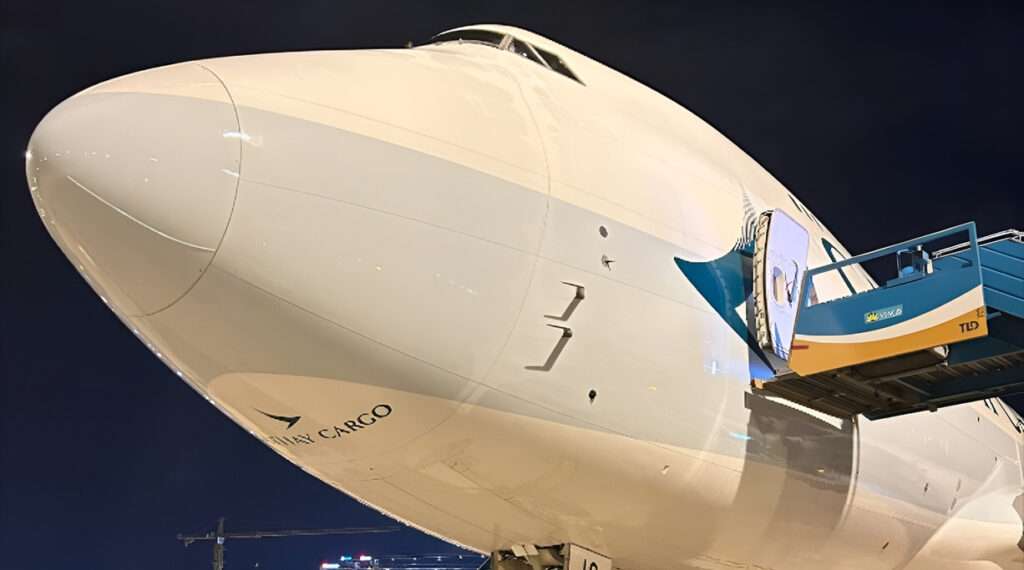The International Air Transport Association (IATA) has released positive news for the air cargo industry.
Global demand for air cargo experienced its fourth consecutive month of double-digit year-on-year growth in March 2024, a sign of continued recovery and positive momentum.
This robust performance surpasses even the exceptional first quarter of 2021, a period marked by significant disruptions due to the COVID-19 pandemic.
Air Cargo on an Upward Trajectory
Looking at the numbers, total cargo tonne-kilometers (CTKs), a key metric for measuring air cargo demand, rose by 10.3% compared to March 2023.
International operations led the way with an impressive 11.4% increase, highlighting the growing importance of global trade flows.
This strong performance indicates a continued shift towards pre-pandemic air cargo movement patterns and potentially even surpassing them.
Capacity Expansion Supports Growth
While demand surges, air cargo capacity is also keeping pace. Available cargo tonne-kilometers (ACTKs) grew by 7.3% globally compared to March 2023.
International operations again saw a more significant rise of 10.5%, indicating airlines are strategically adding capacity to meet the growing demand for air cargo services.
This balance between demand and capacity ensures efficient operations and potentially helps stabilize air cargo prices.

IATA Optimistic for 2024
With these positive trends, Willie Walsh, IATA’s Director General, expressed optimism for the remainder of the year.
“Air cargo demand’s 10.3% growth year-over-year contributes to a strong first quarter, exceeding even the robust 2021 figures. With global trade and industrial production showing a moderate upward trend, 2024 is shaping up to be a solid year for air cargo.”
Factors Influencing the Air Cargo Market
The IATA report goes beyond just headline figures and delves into several factors influencing the air cargo market:
- Global Trade and Production: Both global cross-border trade and industrial production exhibited moderate growth in February.
The Purchasing Managers’ Index (PMI) for manufacturing output exceeded 50, indicating expansion in the sector.
However, new export orders remain cautious, with a PMI slightly below the growth threshold. This suggests that while production is increasing, businesses may be hesitant to commit to large-scale exports yet.
- Inflation: Inflation trends varied across regions in March. The EU and Japan saw a decrease, while the US experienced a slight rise.
Notably, China returned to deflation after a brief period of inflation in February. Fluctuations in inflation can impact consumer spending and therefore indirectly affect air cargo demand, as businesses may adjust their production and transportation strategies.

Regional Performance: A Mixed Bag with Strong Players
The report also highlights the varying performance of different regions in the air cargo market:
- Asia-Pacific Takes the Lead: Airlines in the Asia-Pacific region led demand growth at 14.3% year-on-year.
This strong performance was driven by robust trade flows on both the Asia-Europe and intra-Asia routes. These routes are crucial for the movement of manufactured goods and other high-value cargo.
- North America Shows Modest Growth: North American carriers experienced the weakest growth at 0.9%, but this still represents a positive trend.
Key trade lanes like North America-Europe and Asia-North America saw continued movement, suggesting a focus on maintaining established trade partnerships.

- Europe on the Rise: European airlines reported a 10.0% increase, with particularly strong growth in intra-European and Europe-Middle East routes.
This could be attributed to a combination of factors, including increased regional trade activity and potential spillover effects from disruptions in other transportation sectors.
- Middle East Emerges as a Powerhouse: Middle Eastern carriers enjoyed the highest regional growth at 19.9%.
This impressive performance was fueled by robust demand on the Middle East-Europe and Middle East-Asia routes. The region’s strategic location and well-developed air cargo infrastructure likely played a significant role in this growth.

- Latin America and Africa See Positive Movement: Latin America and Africa also saw positive growth, with Latin America at 9.2% and Africa at 14.2%.
While these regions may not be as dominant players as Asia or the Middle East, their growth signifies a potential for further expansion in the air cargo market.
Looking Ahead: A Promising Year for Air Cargo
The air cargo industry appears to be on a positive trajectory, with strong demand, a recovering capacity, and a mix of regional growth drivers.
While some regional variations exist, the overall picture points towards a promising year for air cargo transportation. Continued monitoring of global economic conditions, trade policies, and fuel prices will be vital.

Click the banner to subscribe to our weekly newsleter.

Click the photo to join our WhatsApp channel so then you can stay up to date with everything going on in the aviation industry!









